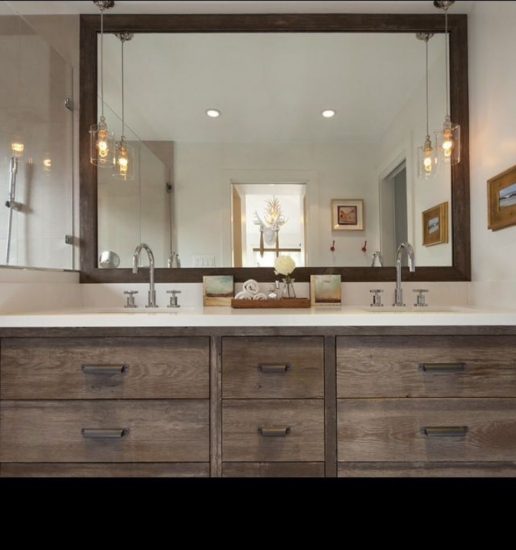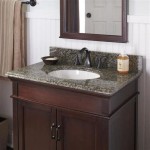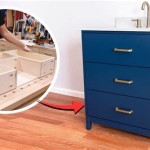How Tall Should a Vanity Mirror Be?
The selection of a vanity mirror is a crucial element in bathroom design, impacting both functionality and aesthetics. The optimal height of a vanity mirror is not a one-size-fits-all answer; it depends on a variety of factors, including the height of the users, the dimensions of the vanity itself, and the desired overall visual effect of the space. A poorly sized or positioned mirror can lead to discomfort, inefficient use, and an unbalanced aesthetic. Therefore, careful consideration must be given to determining the appropriate height for each individual circumstance.
Several elements contribute to determining the proper height for a vanity mirror. A primary consideration is ergonomics: the mirror must be placed at a height that allows all users to comfortably see their reflections without the need to strain or bend. The dimensions of the vanity, including its width and overall height, also play a significant role in creating a balanced and aesthetically pleasing composition. Furthermore, the style of the bathroom and the intended design aesthetic will influence the choice of mirror size and placement. This article will explore these factors in detail, providing a comprehensive guide to determining the ideal height for a vanity mirror.
User Height and Viewing Angle
The height of the individuals who will be using the vanity is the most critical factor in determining the appropriate mirror height. The primary objective is to ensure that all users can comfortably see their face and upper body in the mirror. A general guideline is to position the center of the mirror at approximately eye level for the average user. However, this "average" eye level can vary significantly, particularly if there is a large discrepancy in height between household members.
To accommodate multiple users with varying heights, a compromise must often be reached. One common approach is to position the mirror at a height that is comfortable for the tallest user, while providing a smaller, adjustable mirror or magnifying mirror for shorter users. This supplementary mirror can be mounted on an adjustable arm or placed on the countertop, allowing for personalized adjustments as needed. Another option is to consider a taller mirror that spans a larger vertical area, ensuring that even shorter users can still see themselves without excessive straining. The objective is to find a solution that minimizes discomfort for all users while maintaining an aesthetically pleasing design.
The viewing angle also plays a crucial role in determining the optimal mirror height. The distance between the user and the mirror, as well as the angle at which the user views their reflection, will impact the perceived image. A mirror that is positioned too high or too low can result in distortion or an incomplete view. To ensure a comfortable and accurate reflection, the mirror should be positioned so that the user can see their entire face and upper body without having to tilt their head or strain their neck. This can be achieved by experimenting with different mirror heights and viewing angles before permanently mounting the mirror.
Vanity Dimensions and Placement
The dimensions of the vanity itself are a significant factor in determining the appropriate mirror size and placement. The width of the mirror should ideally correspond to the width of the vanity, or be slightly narrower. A mirror that is significantly wider than the vanity can appear disproportionate and unbalanced. Similarly, a mirror that is too narrow can look lost and insignificant, failing to provide adequate reflection space.
The height of the vanity also influences the optimal height of the mirror. A typical bathroom vanity has a height of around 30 to 36 inches. If the vanity is taller than average, the mirror will need to be positioned higher to maintain a comfortable viewing angle. Conversely, if the vanity is shorter than average, the mirror may need to be positioned lower. The objective is to create a visually balanced composition where the mirror and vanity are in proportion to each other. A common practice is to leave a small gap between the top of the vanity and the bottom of the mirror, creating a visual separation and preventing the two elements from appearing too crowded. This gap can typically range from a few inches to several inches, depending on the desired aesthetic.
The placement of the vanity within the bathroom also plays a role in determining the appropriate mirror height. If the vanity is positioned in a small or narrow space, a taller mirror can help to create the illusion of more space and height. By reflecting more of the surrounding environment, the mirror can make the room feel larger and more open. Conversely, if the vanity is positioned in a large or spacious bathroom, a smaller mirror may be more appropriate to avoid overwhelming the space. The objective is to choose a mirror size and placement that complements the overall dimensions of the bathroom and enhances the sense of proportion and balance.
Bathroom Style and Design Aesthetics
The overall style of the bathroom and the intended design aesthetics will also influence the choice of mirror size and placement. In a modern or minimalist bathroom, a large, frameless mirror that spans the entire width of the vanity can create a sleek and contemporary look. This type of mirror often extends from the countertop to near the ceiling, maximizing the reflective surface and creating a sense of spaciousness. Conversely, in a more traditional or ornate bathroom, a smaller, framed mirror with decorative details may be more appropriate. The frame can be chosen to complement the other design elements in the bathroom, such as the faucets, lighting fixtures, and cabinetry.
The shape of the mirror is another important consideration. While rectangular mirrors are the most common choice, other shapes such as oval, round, or arched mirrors can also be used to create a unique and interesting design. Round mirrors, in particular, can soften the angular lines of a bathroom and add a touch of elegance and sophistication. The choice of mirror shape should be guided by the overall style of the bathroom and the personal preferences of the homeowner.
The lighting around the vanity mirror also plays a critical role in creating a functional and aesthetically pleasing space. Proper lighting is essential for tasks such as applying makeup, shaving, and styling hair. The lighting should be positioned to illuminate the face evenly, without casting harsh shadows or glare. Sconces mounted on either side of the mirror are a popular choice, as they provide balanced and flattering light. Overhead lighting, such as recessed lights or a decorative chandelier, can also be used to supplement the sconces and provide overall ambient lighting for the bathroom. The color temperature of the lighting is another important consideration. Warm white light is generally preferred for bathrooms, as it creates a more inviting and natural atmosphere. Cool white light, on the other hand, can be too harsh and clinical.

Bathroom Mirror Size Calculator

Bathroom Mirror Size Calculator

How To Choose The Best Size Mirror Olde Good Things

What Is The Standard Height Of A Bathroom Vanity 2024 Guide

How To Hang A Wash Basin Mirror Step By Guide Accent

How High To Hang A Vanity Mirror Sparrow Stoll

Bathroom Sconces Where Should They Go Designed
Bathroom Design Quick Tip Where To Place The Mirror When Your Sink Is Off Center Designed

How To Choose The Perfect Vanity Mirror Ryan S All Glass

How High To Hang A Vanity Mirror Sparrow Stoll







